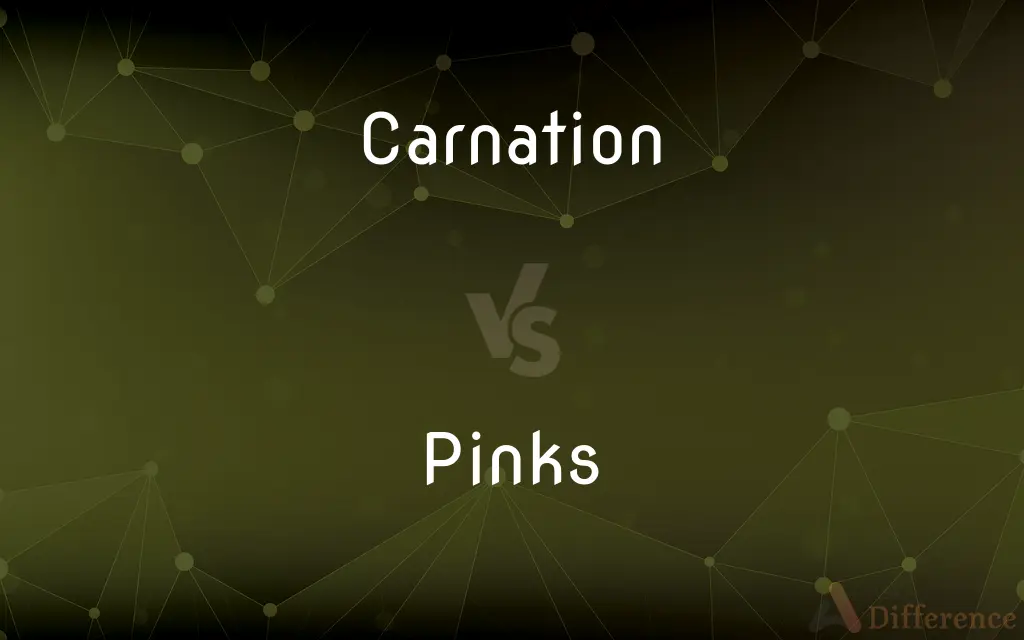Carnation vs. Pinks — What's the Difference?
By Urooj Arif & Fiza Rafique — Updated on April 24, 2024
Carnations are a popular flowering plant known for their ruffled petals and clove-like scent, while Pinks, part of the same botanical family, are prized for their distinct fringe-like petals and strong, sweet fragrance.

Difference Between Carnation and Pinks
Table of Contents
ADVERTISEMENT
Key Differences
Carnations, formally known as Dianthus caryophyllus, feature a wide variety of colors and a distinctive, spicy aroma that is often associated with floral arrangements and bouquets. Whereas Pinks, which refer to various species within the Dianthus genus, often exhibit a smaller size and a more delicate fringe on the edge of their petals.
Both Carnations and Pinks are celebrated for their longevity in cut floral arrangements and their ability to bloom in a range of colors. On the other hand, Pinks generally have a stronger, more sweetly fragrant scent compared to the spicy fragrance of carnations.
Carnations are commonly used in events such as weddings, Mother’s Day, and as boutonnieres due to their full, ruffled form and extensive palette of colors. Whereas Pinks, with their subtle charm and less robust form, are more commonly used in gardens and informal floral displays.
The care and cultivation of both Carnations and Pinks are similar, as they both require well-drained soil and ample sunlight. However, Pinks are often considered slightly easier to grow in rock gardens and alpine conditions, where their tolerance for drought and poor soil is advantageous.
Comparison Chart
Botanical Name
Dianthus caryophyllus
Dianthus spp.
ADVERTISEMENT
Common Usage
Bouquets, floral arrangements, boutonnieres
Gardens, informal floral displays
Petal Appearance
Ruffled edges, broader petals
Fringed edges, delicate petals
Scent
Spicy, clove-like
Strong, sweet
Growth Requirement
Well-drained soil, full sun
Well-drained soil, full sun, tolerates poor conditions
Compare with Definitions
Carnation
A perennial flower known for its layered, ruffled petals.
The florist decorated the hall with pink and white carnations.
Pinks
Known for their sweet fragrance and petite size.
The scent of pinks filled the evening air at the garden party.
Carnation
Commonly associated with symbolic meanings like love and fascination.
Red carnations are often given on Mother's Day to symbolize admiration.
Pinks
Often found in pastel colors and various shades of pink.
She planted an array of pinks to achieve a gradient effect in her rock garden.
Carnation
Known for a strong, pleasant aroma.
The room was filled with the spicy scent of fresh carnations.
Pinks
Prefer rocky, well-drained soil and are easy to maintain.
Pinks are ideal for those new to gardening due to their low maintenance.
Carnation
Available in a wide range of colors due to extensive cultivation.
Carnations can be found in almost every shade except true blue.
Pinks
Dianthus flowers with a distinct notched petal margin.
The garden was bordered with fragrant pinks blooming profusely.
Carnation
Used extensively in the floral industry.
Carnations are popular choices for prom corsages and boutonnieres.
Pinks
Popular in cottage gardens and informal landscapes.
Her cottage garden featured a charming mix of pinks and lavender.
Carnation
A double-flowered cultivated variety of clove pink, with grey-green leaves and showy pink, white, or red flowers.
Pinks
Any of a group of colors reddish in hue, of medium to high lightness, and of low to moderate saturation.
Carnation
A rosy pink colour
Sage and carnation throw pillows
Pinks
Any of various plants of the genus Dianthus, such as sweet William, often cultivated for their showy, fragrant, usually pink, red, or white flowers. Also called dianthus.
Carnation
Any of numerous cultivated forms of a perennial plant (Dianthus caryophyllus) having showy, variously colored, usually double, often fragrant flowers with fringed petals.
Pinks
Any of several other plants in the pink family, such as the wild pink.
Carnation
A flower of this plant. Also called clove pink.
Pinks
A flower of any of these plants.
Carnation
A pinkish tint once used in painting.
Pinks
The highest or best degree
In the pink of health.
Carnation
A type of Eurasian plant widely cultivated for its flowers.
Pinks
Light-colored trousers formerly worn as part of the winter semidress uniform by US Army officers.
Carnation
Originally, Dianthus caryophyllus
Pinks
The scarlet coat worn by fox hunters.
Carnation
Other members of genus Dianthus and hybrids
Pinks
(Slang)A pinko.
Carnation
The type of flower they bear, originally flesh-coloured, but since hybridizing found in a variety of colours.
Pinks
A small sailing vessel with a sharply narrowed stern and an overhanging transom.
Carnation
A rosy pink colour
Pinks
Of the color pink.
Carnation
(archaic) The pinkish colors used in art to render human face and flesh
Pinks
(Slang)Having moderately leftist political opinions.
Carnation
A scarlet colour.
Pinks
To stab lightly with a pointed weapon; prick.
Carnation
Of a rosy pink or red colour.
Pinks
To decorate with a perforated pattern.
Carnation
(archaic) Of a human flesh color.
Pinks
To cut with pinking shears.
Carnation
The natural color of flesh; rosy pink.
Her complexion of the delicate carnation.
Pinks
Plural of pink
Carnation
Those parts of a picture in which the human body or any part of it is represented in full color; the flesh tints.
The flesh tints in painting are termed carnations.
Pinks
Flowers in the family Caryophyllaceae, sometimes called carnations.
Carnation
A species of Dianthus (Dianthus Caryophyllus) or pink, having very beautiful flowers of various colors, esp. white and usually a rich, spicy scent.
Pinks
The traditional scarlet jacket(s) worn by fox-hunters in the United Kingdom.
Carnation
Eurasian plant with pink to purple-red spice-scented usually double flowers; widely cultivated in many varieties and many colors
Carnation
A pink or reddish-pink color
Carnation
Having the color of a carnation
Common Curiosities
How often should Carnations and Pinks be watered?
They require moderate watering, with special attention during dry spells to maintain moist, well-drained soil.
Why are Pinks called 'Pinks'?
The name 'Pinks' does not refer to their color but to the fringed edge of the petals, which looks as though it has been cut with pinking shears.
Can Carnations and Pinks be grown together?
Yes, both can be grown together as they share similar soil and sunlight requirements.
Do Carnations have any symbolic meanings?
Yes, carnations carry various meanings, including love, fascination, and distinction.
Are Pinks suitable for container gardening?
Pinks are excellent for container gardening due to their compact size and hardiness.
What makes Pinks different from other Dianthus species?
Pinks are particularly noted for their distinctive fringed petals and strong, sweet fragrance.
What is the best time to plant Pinks?
Early spring or fall is ideal for planting Pinks to establish roots before extreme weather.
What are Carnations used for?
Carnations are widely used in floral arrangements, ceremonies, and as personal adornments like boutonnieres.
What are the best conditions for growing Pinks?
Pinks perform best in full sun with well-drained, slightly alkaline soil.
What is the lifespan of Carnations and Pinks in a garden?
Both are perennials under proper conditions, lasting several years in the garden.
Do Carnations need a lot of sunlight?
Yes, carnations thrive in full sunlight and require several hours of direct sun daily.
What pests should I watch for with Carnations and Pinks?
Both are susceptible to pests like aphids and fungal diseases like rust and mildew.
What colors do Carnations come in?
Carnations come in a wide variety of colors, including pink, red, white, yellow, and purple.
How can I propagate Carnations?
Carnations can be propagated through cuttings, seeds, or division of clumps.
Can I use Pinks for a wedding bouquet?
While less common, Pinks can be used in wedding bouquets, particularly for a more rustic or vintage theme.
Share Your Discovery

Previous Comparison
Honey vs. Love
Next Comparison
Stripe vs. StrapAuthor Spotlight
Written by
Urooj ArifUrooj is a skilled content writer at Ask Difference, known for her exceptional ability to simplify complex topics into engaging and informative content. With a passion for research and a flair for clear, concise writing, she consistently delivers articles that resonate with our diverse audience.
Co-written by
Fiza RafiqueFiza Rafique is a skilled content writer at AskDifference.com, where she meticulously refines and enhances written pieces. Drawing from her vast editorial expertise, Fiza ensures clarity, accuracy, and precision in every article. Passionate about language, she continually seeks to elevate the quality of content for readers worldwide.
















































